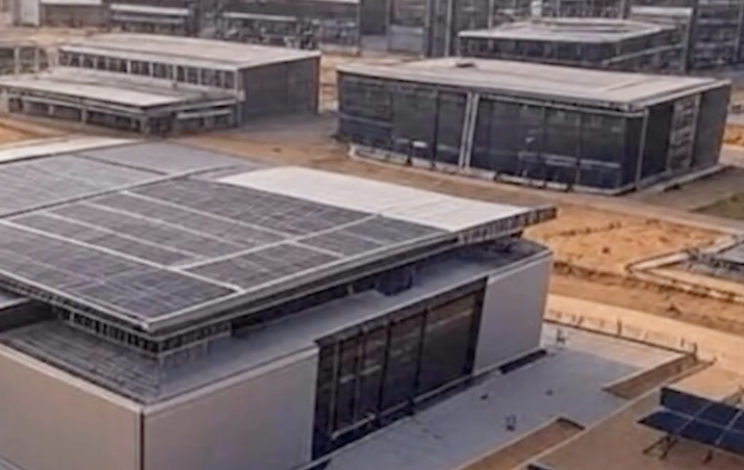(BERKLEY, Calif.) — Ryan Pickering’s fame in the world of solar power started in 2013 when he moved off-grid to a yurt in the hills of Southern California. For the next seven years, he documented what it was like to live in a place entirely powered by the sun on Instagram, launching his influencer career. Pickering claimed that the property was mainly powered by eight solar panels and a lithium-ion battery installed on the roof of the outhouse. However, he knew there would be problems before he even started living there. He knew he couldn’t generate enough electricity to live because he had to run an extension cord to his neighbor’s house just to build the yurt and outhouse. The sun couldn’t power even his tools.
“I was like an off-the-grid guy, living off solar panels … it didn’t work. And I made solar [facilities] for a living,” Pickering said.
“I was famously [living] off-grid, but I was really on grid the whole time,” Pickering said. He never admitted this until he decided to step back from the industry, saving himself the backlash from his solar followers.
“I ran an Instagram page called ‘Sun Power Everything’ where it was like, ‘What if we just power everything with the sun?’ And, you know, I think I was a major cultural influencer,” Pickering said.
During his time at the top of the solar world, Pickering worked with individuals like Bonnie Wright from Greenpeace and the Department of Energy. He said everyone wanted to see a young engineer like himself excited about solar power and being loud about it. People involved with more conventional energy sources condemned his enthusiasm for solar from the start. Still, Pickering said he believed solar power could power the planet, but as time went on and he continued living in the yurt, he understood the reality.
“It’s interesting. When you live in the world of wind and solar, you can actually detach yourself from reality, and that’s what most folks have done,” Pickering said.
During his ensemble, Pickering grew his food, used a composting toilet, and utilized one small electric heater to keep him warm at night since indoor fires were illegal.
Pickering said he tried to live on just the solar panels and batteries for a few weeks after finishing construction but could not. He lived in the yurt for a total of seven years but was connected to the grid for all but just those first 14 days after construction.
“I tried to do just solar and batteries, no grid connection, and then I was forced to dig an illegal trench to my neighbor’s house to get electricity from their meter and had to pay them $150 a month because I couldn’t live without electricity,” Pickering explained. He rationalized doing this because he knew he would not get enough power from the solar and batteries to operate his electric heater. “I would have frozen to death at night,” he said.
Pickering realized that he did not feel good about constructing or promoting this technology anymore after trying to live off-grid with just solar and batteries and then lying about its success to his followers.
Pickering was a senior manager at SunPower Corporation, one of the largest solar companies in the world. After eight years with the company, he was making a good living for himself and was about to do even better as SunPower was grooming him for an executive position. Pickering built over 7,200 solar power facilities in California and truly believed solar was a way for humans to thrive while bringing less harm to the Earth. However, after trying to live in the “off-grid” yurt, Pickering said he realized that installing massive amounts of solar panels to fight climate change and meet current world energy demand is currently impossible.
The world gets its main electricity supply by burning hydrocarbons, including oil, natural gas, and coal. According to data from the International Energy Agency, coal has remained the leading source of electricity generation worldwide for the past three decades. Coal power plants provide a reliable power source at a low price. In 2020, the cost to burn coal for electricity was only $36 per ton. However, burning hydrocarbons like coal brings a high environmental cost, demonstrated through record-high global CO2 emissions, a leading cause of climate change.
After graduating from Loyola Marymount University in 2009, Pickering immediately started as a solar installation designer in California, eventually graduating from the Energy Innovation and Emerging Technologies Program at Stanford University in 2013.
But, after more than ten years in the solar industry, Pickering demoted himself by stepping down from his executive position at SunPower, to working as a sales associate for another solar company, to starting his own company. Pickering founded New Clear Energy LLC in 2021, later transferring to New Clear Energy USA in 2022. “I was really popular at SunPower, really popular, and I made a public nuclear exit [from the company], and people were like ‘wow,'” Pickering said
Pickering’s new company is currently in its infancy, but Pickering said his company aims to provide commercial businesses the opportunity to buy 100% nuclear energy for their buildings.
Pickering said trying to live off-grid with just solar and batteries launched him into deep research about energy as a whole, not just solar energy. He found some significant flaws in the argument that renewable energy can power the world.
He started reading books like “Apocalypse Never: Why Environmental Alarmism Hurts Us All” by Micheal Shellenberger with chapters such as “Destroying the Environment to Save It,” which explains why the claim that renewable energies like solar are better for the environment is not entirely valid.
Shellenberger wrote that in the Spring of 2013, a solar-powered airplane called “Solar Impulse” flew across the U.S. The pilot flew from San Francisco to Phoenix, Dallas, St. Louis, and Washington, DC. Solar Impulse has the same wingspan as a Boeing 747, which can carry 500 people at about 1,000 kilometers an hour. Solar Impulse could only hold the pilot and fly less than 100 kilometers an hour, so it took two months for the solar-powered plane to complete the journey.
Shellenberger concluded that the Solar Impulse mission exemplifies the inherent limits of low power density, like solar.
Chris Bright could not agree more. Bright is an electrical engineer with over thirty years of experience designing, researching, and developing electrical systems for renewable energy systems, nuclear energy, gas turbines, ships, and aircraft. He has learned about all the different energy systems and their setbacks.
Bright said the main issue with renewable energy is the low power density of the resources, meaning that they require a large amount of space to host enough arrays of P.V. solar or wind turbines to produce a significant amount of energy.
Shellenberger wrote that low power density leads to significant environmental impacts even in the sunniest places like California, where the state’s most famous solar farm, Ivanpah, takes 450 times more land than California’s last operating nuclear plant, Diablo Canyon. Shellenberger wrote that a solar farm’s maximum power density is 50 watts of electricity per square meter compared to natural gas and nuclear power plants ranging from 2,000 to 6,000 watts per square meter.
“I calculated that one nuclear power plant the size of my parent’s farm (5 acres) generates more electricity per day than all the solar panels in California combined. California has half of all of the solar panels in the United States,” Pickering said.
Pickering said another limitation is that solar is an intermittent technology, meaning the power is only available while the sun is shining. Lithium-ion batteries are used to try and bridge the gap between power collection and power use. However, Pickering said batteries also have power limitations, making it difficult to run the world on batteries and solar alone. He said that in a world where people expect the light to come on anytime you flip the switch, this is a problem, and it will only worsen as world energy demand continues to rise.
“The world demands constant power, and the inherent nature of solar and wind make it difficult for them to provide energy security completely on their own,” Pickering said. “Because [wind and solar] are intermittent, they require a 24/7 fossil fuel backup.”
Pickering believes this is where nuclear power can step in to help. According to experts like Pickering, nuclear power would solve current energy demand and not create secondary issues the way solar does. He said solar takes up much land and makes waste.
The average P.V. solar plant will last 30 years, wind 20 years, and all battery types only 10. In contrast, the average nuclear power plant lasts 50 years, according to statistics from the World Bank. By 2030, it is estimated that the United States alone will generate 170,000 metric tons of P.V. solar panel waste, something seldom mentioned in the conversation surrounding renewable energy.
A recent op-ed in the Wall Street Journal by Mark P. Mills, a senior fellow at the Manhattan Institute and a faculty fellow at Northwestern University’s McCormick School of Engineering and Applied Science, said that the International Renewable Energy Agency calculates that solar goals for 2050 consistent with the Paris Accords will result in old-solar panel disposal amounting to more than double the tonnage of today’s global plastic waste.
“If we were to run the United States off of just solar power alone, we would have to replace 1 million solar panels every day,” Pickering said. He said that the decommissioned solar panels are complicated to recycle and often end up in landfills.
Francois Byrne, CEO of Hybrid Power Solutions, said technologies like solar should not be discounted. “The solar and wind combination can definitely solve our energy problems and can be used to make a huge impact in the reduction of CO2 and other greenhouse gas emissions,” Byrne said.
Byrne founded Hybrid Power Solutions in 2015 and won Canada’s Young Entrepreneur of the Year award in 2017 for starting Hybrid Power Solutions. Unlike traditional fossil fuel-powered generators, the company designs and manufactures large electric generators for portable use. The company provides portable battery systems and custom energy solutions for various industrial markets, including construction, railway, and military. It aims to create and provide renewable and reusable green technology innovations.
“I don’t see it as a big issue, the use of land, that will definitely correct itself,” Byrne said.
Byrne said that using agricultural land, for instance, to build solar farms is usually because the crop produced was worth less money than if they were to implement solar panels. Adding that eventually, if too much land is used up, then the price of food will rise, and therefore it would be cheaper and more effective to grow food on that land, and so based on financial models, the problem will correct itself.
Yet the history of relying on free market solutions is fraught because producers are driven by profit. Byrne said the problem is that the benefits of solar and wind will take time.
“The number of solar panels required to replace a gas or fossil fuel power plant is immense, so it takes time to make that switch,” Byrne said, adding that the energy grid needs modifying to support solar and wind. The grid was made to support power from a large central source rather than multiple smaller interconnected sources, like wind and solar facilities.
“Is it difficult to do? Yes. Is it impossible to do? No,” Byrne said.
“That being said, I think if you’re starting to look at the future and the strategy to create real changes quickly, I think you’re going to have to look at nuclear as a really, really good option because it creates a very high amount of power in a small area, so it’s very adaptable to the existing grid that we already have,” Byrne said.
However, Byrne said we should not entirely take solar and wind out of the picture, adding that nuclear is not the ultimate solution.
Byrne said nuclear power is not the final answer but just one piece of the puzzle. He compared the renewable energy transition to the gradual mainstream impact of electric cars. Many renewable energy scientists use the phrase “all of the above” when describing the need for wind, solar and nuclear energies while acknowledging that some aspects of human life are currently impossible to conduct without burning hydrocarbons. Byrne is among them and argued that solar, wind, and batteries are renewable transitional technologies.
“We’re starting to get electric cars … but if you look back, 10-15 years [they] didn’t exist really. We started off with the hybrids, which were a better way to improve mileage, and then we transitioned to plug-in hybrids, and then we transitioned to fully electric cars,” Byrne said.
Byrne said that there will never be a one-technology system and that even the cleanest grids use a mix of wind, solar, batteries, and even a tiny amount of fossil fuel. He said the best option for the future is to have the baseline energy load covered by wind, solar, and batteries and then expand into more creative options.
However, Pickering said there’s not enough time to build a system that experts know won’t work.
“We have time to save the world if we build it well,” he said. “12 years in solar taught me that we need nuclear.”


